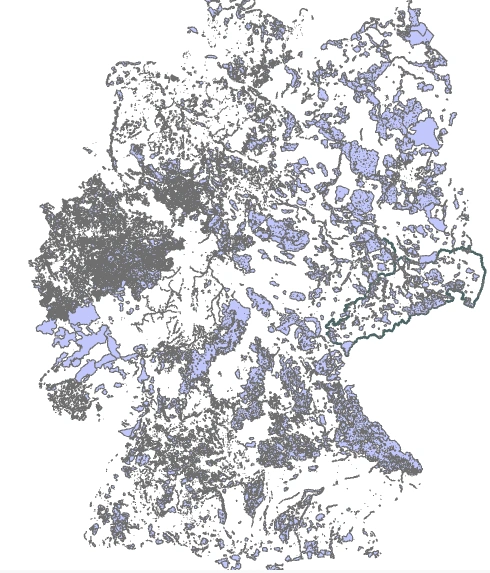Download all Features from all layers of a WFS Service
Download all Features from all layers of a WFS Service and save as separate shapefile per layer (e.g. #BfN #LSG)?
I wanted to get all #WFS features, but neither ArcPro nor QGIS worked here. Wrote a script with #geopandas and #OWSLib and tada, 5 Minutes later..

Opensource! 🚀 👍
These are the steps.
Example to retrieve all WFS Features and store as shapefile with pandas and geopandas.
“BfN Schutzgebiete WFS” https://geodienste.bfn.de/ogc/wfs/schutzgebiet?REQUEST%3DGetCapabilities&SERVICE%3DWFS&VERSION=2.0.0
Setup:
conda create -n wfs_env -c conda-forge
conda activate wfs_env
conda install owslib geopandas requests
First, check capabilities in browser or with:
python get_cap.py
Select your layer, check count.
Edit write_shp.py, update count=1000 and startIndex=ix*1000 - 1000 is an example, update with the maximum number of items to retrieve per iteration, based on the capabilities.
- optionally adapt the WFS format
format='GML'(you can also try removing this parameter for automatic matching) Then run:
python write_shp.py
This will loop through all WFS features:
> https://geodienste.bfn.de/ogc/wfs/schutzgebiet?service=WFS&version=2.0.0&request=GetFeature&typeName=bfn_sch_Schutzgebiet%3ALandschaftsschutzgebiete&count=1000&startIndex=0
> https://geodienste.bfn.de/ogc/wfs/schutzgebiet?service=WFS&version=2.0.0&request=GetFeature&typeName=bfn_sch_Schutzgebiet%3ALandschaftsschutzgebiete&count=1000&startIndex=1000
> https://geodienste.bfn.de/ogc/wfs/schutzgebiet?service=WFS&version=2.0.0&request=GetFeature&typeName=bfn_sch_Schutzgebiet%3ALandschaftsschutzgebiete&count=1000&startIndex=2000
> https://geodienste.bfn.de/ogc/wfs/schutzgebiet?service=WFS&version=2.0.0&request=GetFeature&typeName=bfn_sch_Schutzgebiet%3ALandschaftsschutzgebiete&count=1000&startIndex=3000
.. and concat df’s (pandas (Geo)DataFrames) and finally store features as shapefile. The CRS is not modified and should match the WFS layer’s projection.
Or run:
python write_shp_all.py
This will loop through all layers and retrieve all features and store them in separate shapefiles.
write_shp_all.py:
"""Fetch all features and all layers of a WFS service
and store as a single shapefile per layer.
"""
__version__ = '2024-01-07'
__author__ = 'Alexander Dunkel'
from requests import Request
from owslib.wfs import WebFeatureService
import geopandas as gp
import pandas as pd
# URL for WFS backend
url = "https://geodienste.bfn.de/ogc/wfs/schutzgebiet"
# Initialize
wfs = WebFeatureService(url=url)
layers = list(wfs.contents)
def fetch_features(layer_name, fetch_cnt: int, ix: int) -> gp.GeoDataFrame:
"""Fetch features and return as GeoDataFrame"""
params = dict(service='WFS', version="2.0.0", request='GetFeature',
typeName=layer_name, count=fetch_cnt, startIndex=ix*fetch_cnt)
# Parse the URL with parameters
wfs_request_url = Request('GET', url, params=params).prepare().url
print(wfs_request_url)
# df = gp.read_file(wfs_request_url)
try:
df_new = gp.read_file(wfs_request_url, format='GML')
except ValueError:
return
return df_new
def loop_layer(
layer_name, max_loops: int = 100, item_fetch_cnt: int = 1000) -> gp.GeoDataFrame:
"""Specify the parameters for fetching the data
max_loops: how many iterations per layer max
item_fetch_cnt: specificies amount of rows to return per iteration
(e.g. 10000 or 100); check capabilities in browser first
startIndex: specifies at which offset to start returning rows
"""
df = None
cnt = 0
for ix in range(100):
df_new = fetch_features(layer_name, item_fetch_cnt, ix)
if df_new is None:
print("Empty received, aborting..")
break
new_cnt = len(df_new)
if new_cnt == 0:
# empty result
# all rows fetched?
break
cnt += new_cnt
print (f"Round {ix}, retrieved {cnt} features", end="\r")
if df is None:
df = df_new
else:
df = pd.concat([df, df_new])
if new_cnt < item_fetch_cnt:
break
return df
for layer_name in layers:
# Fetch all features for all layers
print(f'Fetching layer {layer_name}')
df = loop_layer(layer_name=layer_name)
# sanitize layername
layer_name_fine = "".join(x for x in layer_name if x.isalnum())
df.to_file(f'2024-01-07_bfn_{layer_name_fine}.shp')
See a gist here: https://gist.github.com/Sieboldianus/7167d4c93aa073ac327bc03423d4b642